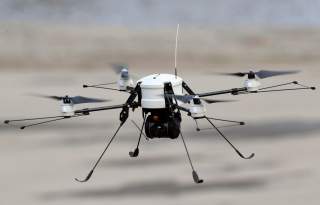Will Taiwan's Suicide Drones Make a Difference If China Invades?
Too little, too late?
Key Point: Taipei knows the balance of power has shifted. As a result, Taiwan is trying out all kinds of new ways to defend itself.
A new suicide drone appeared at the August 2019 edition of the biennial Taipei Aerospace & Defense Technology Exhibition in the island country’s capital.
This first appeared in 2019 and is being reposted due to reader interest and is being reposted due to reader interest.
The unmanned aerial vehicle bears a strong resemblance to the small, hand-launched drones that are popular with U.S. forces. The other clearly draws inspiration from Israel’s Harpy anti-radar drone.
A suicide drone essentially is a small, inexpensive cruise missile, usually possessing some loitering capability. They might include a simple seeker head. Alternately, their operators remotely could steer them toward their targets.
Often based on commercial UAVs, suicide drones typically pack a small, grenade-size explosive warhead.
The Fire Cardinal drone, which first appeared at the Taipei trade show, is “an air-to-ground strike assault UAV,” according to the aviation-news website Alert 5, citing information from the show.
The twin-propeller Fire Cardinal is around four feet long, has a six-foot wingspan and weighs around 15 pounds. It includes an electro-optical and infrared sensor and selects its target using what Alert 5 described as an “intelligent object-detection system.”
Alert 5 did not speculate as to Fire Cardinal’s range, but it’s roughly the same size as the U.S. Army’s hand-launched Puma surveillance drone. The propeller-driven Puma can range as far as 10 miles at an altitude of 500 feet and a maximum speed of around 50 miles per hour.
A human operator controls a Puma via radio. It’s safe to assume the Fire Cardinal, with its own modest range and performance, features a similar control system. Ground troops in close proximity to enemy forces could lob many Fire Cardinals into the air in the hope of overwhelming the enemy’s short-range air defenses.
That’s the tactic that militant forces in the Middle East have employed with their own, custom-made suicide drones. In January 2018 a swarm of 10 explosives-laden small drones, apparently controlled by Syrian rebels, attacked two Russian bases in western Syria.
Meanwhile, three drones attacked Russian facilities at the nearby port of Tartus. The Kremlin claimed that a Pantsir-S air-defense system shot down seven of the drones while Russian electronic-warfare specialists hacked six of the UAVs and ordered them to land.
Taiwan’s other suicide drone targets the air-defenses themselves. The Chien Hsiang first appeared in 2017 at the Taipei trade show. It bears a striking resemblance to the eight-foot-long Israeli Harpy UAV. The Harpy packs a relatively powerful, 70-pound warhead and cruises as fast as 115 miles per hour out to a distance of nearly 300 miles.
Taiwan Air Force’s Air Defense and Missile Command said it would spend $2.5 billion developing the truck-launched Chien Hsiang through the early 2020s.
“The domestically produced anti-radiation UAV can detect and attack radar emitters on enemy vessels or electromagnetic wave sources in their weapon systems,” UAS Vision noted, citing Taiwanese media. “Their flight range is said to be able to cover radar stations along China’s southeastern coast.”
Taiwan is counting on drones to counter China’s expanding advantage in ships, planes and troops. China can muster potentially thousands of aircraft, hundreds of ships and hundreds of thousands of troops for a possible invasion of Taiwan.
Taiwan’s own military fields fewer than 300 fighters, just a few dozen major warships and 100,000 ground troops. The island country has rushed to develop a wide array of missiles and drones to boost its invasion-defenses.
Taiwanese media on Aug. 4, 2019, reported that the country’s National Chung-Shan Institute of Science and Technology had cleared the Yun Feng cruise missile for mass production.
The supersonic land-attack missile has been under development since the 1990s. It can fly as far as 1,200 miles, according to the Center for Strategic and International Studies in Washington, D.C.
That range could allow Taiwan to threaten many of the airbases, ports and other facilities from which China likely would stage any attempt to invade Taiwan.
Taipei reportedly is building an initial 20 Yun Feng missiles as well as 10 truck-based launchers. Taiwan’s Up Media described the missiles as “the top priority of the various studios of the Chinese Academy of Sciences.”
Taiwan also is developing a new air-launched cruise missile -- and reportedly has attempted to reverse-engineer old, U.S.-made J85 engines apparently to power the munition.
David Axe serves as Defense Editor of the National Interest. He is the author of the graphic novels War Fix,War Is Boring and Machete Squad. This first appeared in 2019 and is being reposted due to reader interest and is being reposted due to reader interest.
Image: Reuters

